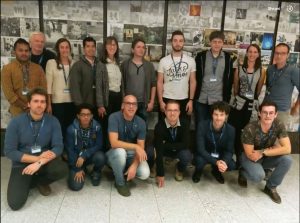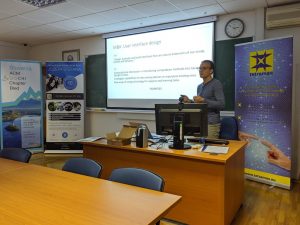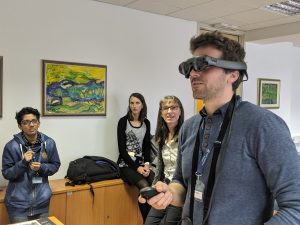| From | To | Location | |
| 09:00 | 09:45 | Avla Galeb | REGISTRATION |
| 09:45 | 10:00 | Avla Galeb | Welcome by the Chairs |
| 10:00 | 11:00 | Avla Galeb | SESSION 1: Opening Keynote (Chair: Matjaž Kljun) |
| 10:00 | 11:00 | Keynote: Gregor Geršak | |
| 11:00 | 11:30 | Avla Galeb | POSTER/COFFEE BREAK |
| 11:30 | 12:30 | Avla Galeb | SESSION 2: Papers (Chair: Veljko Pejović) |
| 11:30 | 11:45 | Elham Motamedi and Marko Tkalcic. Prediction of Eudaimonic and Hedonic Movie Characteristics From Subtitles | |
| 11:45 | 12:00 | Mateja Jovanović, Vida Groznik and Marko Tkalčič. Predicting the Gullibility of Users from their Online Behaviour. | |
| 12:00 | 12:15 | Patrik Kocjančič, Kljun Matjaž and Klen Čopič Pucihar. Primerjava vnosa besedila v virtualnem okolju na različnih postavitvah tipkovnice (Comparison of text entry on dierent keyboard layouts in virtual reality) | |
| 12:15 | 12:30 | Maheshya Weerasinghe, Klen Čopič Pucihar and Matjaž Kljun. Playing with the Artworks: A personalised artwork experience | |
| 12:30 | 14:30 | LUNCH BREAK | |
| 14:30 | 15:30 | Avla Galeb | SESSION 3: Papers (Chair: Klen Čopič Pucihar) |
| 14:30 | 14:45 | Anže Kristan, Daniel Pellarini and Veljko Pejović. Not Deep Enough: Autoencoders for Automatic Feature Extraction in Wireless Cognitive Load Inference | |
| 14:45 | 15:00 | Andraž Krašovec and Veljko Pejovic. Investigating Sensor Modality Informativeness and Stability for Behavioural Authentication | |
| 15:00 | 15:15 | Sead Hrustanović, Branko Kavšek and Marko Tkalčič. Recognition of eudaemonic and hedonic qualities from song lyrics | |
| 15:15 | 15:30 | Jose Maria Iii Santiago, Giselle Nodalo, Jolene Valenzuela and Jordan Aiko Deja. Explore, Edit, Guess: Understanding Novice Programmers’ Use of CodeBlocks for Regression Experiments | |
| 15:30 | 16:00 | Avla Galeb | POSTER/COFFEE BREAK |
| 16:00 | 17:00 | VP2 | SESSION 4: Closing Keynote (Chair: Marko Tkalčič) |
| 16:00 | 17:00 | Keynote: Peter Knees | |
| 17:00 | 18:00 | Panel/Wrap up |
Keynote speakers for HCI SI will be Peter Knees and Gregor Geršak
Peter Knees is Associate Professor at the Vienna University of Technology, Faculty of Informatics. He is an active member of the Music Information Retrieval research community, reaching out to the related fields of multimedia and text information retrieval, recommender systems, and the digital arts. His research activities center on music search engines and interfaces as well as music recommender systems, and more recently, on smart(er) tools for music creation. He co-authored the book “Music Similarity and Retrieval: An Introduction” and is a contributor of the Digital Humanism initiative.
Gregor Geršak received the Ph.D. degree from the Faculty of Electrical Engineering, University of Ljubljana. His research interests include the theory of measurements, precision measurement of magnetic flux density, and pressure and thermometry. His focus is on metrology of biomedical instrumentation with emphasis on devices for non-invasive blood pressure measurement and psychophysiological measurements.
HCI SI 2021
We had a wonderful time last year. Welcome to join us this year!
For details, see call for papers – click here.
Join us online! HCI-IS 2020 digital venue
Due to you-know-what, the conference will happen online. It is open to the public, if you are interested, you are welcome to join us. Check out the schedule to get an idea of the topics covered.
Link: https://upr-si.zoom.us/j/83774273221
Register here to get info on how to access the conference on Wednesday the 7th of October: https://forms.gle/rpi1Ua2bfcKfTHbQ8
HCI-IS 2020 schedule
9:00-9:15: Welcome speech
Veljko Pejović, conference chair
9:15-10:00 Keynote
Marko Tkalčič
10:00-10:10 Break
10:10-11:00 SESSION A:
Voice technologies and sound (Luka Čehovin Zajc, session chair)
- MightyFields Voice: Voice-based Mobile Application Interaction (Jernej Zupančič, Miha Štravs, Miha Mlakar)
- eBralec4: hibridni sintetizator slovenskega govora (Jerneja Žganec Gros, Miro Romih, Tomaž Šef)
- Sound 2121: The Future of Music is Natural (Jordan Aiko Deja, Nuwan T Attygalle, Matjaž Kljun, Klen Čopič Pucihar)
- Učinkovita predstavitev slovarskih jezikovnih virov pri govornih tehnologijah (Jerneja Žganec Gros, Žiga Golob, Simon Dobrišek)
- The Fundamentals of Sound Field Reproduction Using a Higher Order Ambisonics System (Rok Prislan)
11:00-11:10 Break
11:10-12:00 SESSION B:
Interactive projections and visualisation (Jože Guna, session chair)
- Interaktivna vizualizacija proračuna Republike Slovenije s Sankeyevim diagramom (Tea Tušar)
- Ohranjanje kulturne dediščine s pomočjo navidezne in obogatene resničnosti (Marko Plankelj, Niko Lukač, Selma Rizvić, Simon Kolmanič)
- Razvoj in Ocenjevanje Prototipa Mobilne Aplikacije z Elementi Igrifikacije in Mešane Resničnosti (Monika Zorko, Matjaž Debevc, Ines Kožuh)
- StreetGamez: detection of feet movements on the projected gaming surface on the floor (Peter Škrlj, Matjaž Kljun, Klen Čopič Pucihar)
- Anamorfična projekcija na poljubno neravno površino (Rok Cej, Franc Solina)
12:00-12:45 Lunch break
12:45-13:35 SESSION C:
eLearning, eHealth and advertising (Vida Groznik, session chair)
- Predmetnik: oprijemljiv uporabniški vmesnik za informiranje turistov (Sotlar Gregor, Klen Čopič Pucihar, Peter Roglej, Matjaž Kljun)
- Investigating the Role of Context and Personality in Mobile Advertising (Andrej Martinovic, Veljko Pejovic)
- The use of eCare services among informal carers of older people and psychological outcomes of their use ( Kaja Smole Orehek, Vesna Dolnicar, Simona Hvalič Touzery)
- Integration of online tools to formal education (Bojan Žunkovič, Francisco Gutierrez)
- Smeri razvoja in arhitekturni opis EMZ platforme (Primož Kocuvan, Miha Štravs, Matjaž Gams)
13:35-13:45 Break
13:45-14:45 SESSION D:
Presentations of published work and other projects (Matevž Pesek, session chair)
14:45-14:50 Final remarks (all)
Deadline extended!
Due to popular request … you know how this goes. 🙂
New deadline for our HCI-IS conference is 10 September 2020.
See you soon!
HCI-IS 2020
We had a wonderful time last year. Welcome to join us this year!

For details, see call for papers – click here.
HCI-IS 2019 proceedings

human computer interaction in information society 2019
Human-computer interaction in information society is a conference organized by the Slovenian HCI community. The purpose of the conference is to gather researchers, practitioners and students in the field and offer the opportunity to exchange experiences and research results, as well as to establish contacts for future cooperation.

human computer interaction in in formation society 019
This year’s fourth reincarnation of the conference is, for the first time, organized by the newly established SIGCHI Chapter ACM Chapter Bled, which is partly a result previous
conferences. The growth of the HCI community in the region is also witnessed by the doubled number of contributions coming from all major higher education institutions in Slovenia and abroad.
The topics covered by the conference range from the more established ones, such as usability testing, visualization and design of graphical user interfaces to virtual and augmented reality, user interfaces in healthcare, automotive industry, arts and e-learning.
You can view the full proceedings and some photos of the event.

HCI-IS 2019 keynote & schedule
Some more information for tomorrow’s conference. See you soon!
KEYNOTE
Title: Mobile Interruptibility Management: The Role of Social Roles
Abstract: As we go about our daily lives we enact different social roles, with work and private roles being the most prominent. The traditional role boundaries have been shattered with the introduction of mobile communication devices – a work-related email might arrive during a family dinner, while a private chat message might buzz in a business meeting. While role blurring introduced with mobile phones might increase stress due to role conflict, it can also simplify task handling and provide the necessary flexibility (e.g. an option to work from home). In this talk I will present a line of research on mobile interruptiblity with a particular focus on the impact of social roles on notification handling. We will see how mobile device usage varies with the currently enacted social role, as well as how preferences for notification handling vary among individuals. Finally, I will discuss our vision of a system that matches the desired role boundary handling with the way notifications are managed on mobile devices.
Bio: Veljko Pejovic is an assistant professor of computer science at the University of Ljubljana, Slovenia. His interests include mobile computing, HCI, resource-efficient computing, and the interaction of technology and society. His work on modelling user movement and communication behavior from mobile call records won the 2013 Orange D4D Challenge, while his work on interruptibility modelling resulted in the best paper nomination at the ACM UbiComp’14 conference.
SCHEDULE
Download schedule of Human-Computer Interaction in Information Society 2019 available here.

HCI-IS 2019 accepted papers, posters and presentations
RESEARCH PAPERS
Analiza vpliva težavnosti računalniške igre na izmerjene vrednosti fizioloških signalov
Timotej Knez, Martin Gjoreski, Veljko Pejović
Privacy preserving indoor location and fall detection system
Aleksandar Tošić, Jernej Vičič, Michael Burnard
Exploratory data analysis of stream data in sports medicine domain
Maja Vrancich, Maja Matetic
Sledenje pogledu s spletno kamero
Luka Vranješ, Jure Žabkar
Prepričljive tehnologije za spodbujanje pravilne drže telesa pri sedenju
Luka Zorč, Klen Čopič Pucihar, Matjaž Kljun
Nuni-A case study: a platform to distribute digital content to analog television data towards enhancing quality of life of senior citizen in Mexico
Cuauhtli Campos, Carlos Alberto Martínez Sandoval
EXTENDED ABSTRACTS
Umestitev interaktivnih elementov in elementov igrifikacije na vnaprej zastavljeni učni poti
Borut Kolar, Matjaž Kljun, Klen Čopič Pucihar
Interakcija z umetniškimi deli preko množičnega ocenjevanja
Patrik Širol, Klen Čopič Pucihar, Matjaž Kljun
Igrifikacija virtualnega obiska učne poti Škocjan z uporabo mobilnih tehnologij in 360-stopinjskih posnetkov
Tilen Jesenko, Matjaž Kljun, Klen Čopič Pucihar
Virtual reality and neurocognitive intervention: an active game-based rehabilitation approach towards assisting autistic children with cognitive deficit
Maheshya Weerasinghe, Nuwan Attygalle, Julie Ducasse
Interakcija z umetninami z uporabo tehnologije dopolnjene resničnosti
Boštjan Čotar, Matjaž Kljun, Klen Čopič Pucihar
POSTERS
The missing interface: micro-gestures on augmented objects
Klen Čopič Pucihar, Christian Sandor, Matjaž Kljun, Wolfgang Huerst, Alexander Plopski, Takafumi Taketomi, Hirokazu Kato, Luis A. Leiva
3D virtual tracing and depth perception problem on mobile AR
Leon Gombač, Klen Čopič Pucihar, Matjaž Kljun, Paul Coulton, Jan Grbac
Playing with the artworks: engaging with art throughan augmented reality game
Klen Čopič Pucihar, Matjaž Kljun, Paul Coulton
Dual camera magic lens for handheld AR sketching
Klen Čopič Pucihar, Jens Grubert, Matjaž Kljun
Conference schedule will follow soon.
Note: links to camera-ready papers are added as they come in. Conference proceedings available here.
